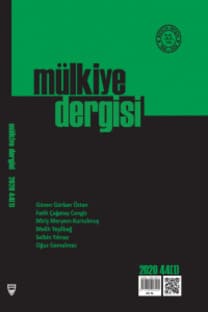2011 Yazında Orta Doğu’yu Düşünürken / Considering the Middle East in the Summer of 2011
Bu yazı, tanıtıcı Giriş Bölümü ile bunu izleyen beş bölümden oluşmaktadır. İkinci Bölüm’de Orta Doğu için 1873-2010 dönemini kapsayan özlü bir tarihsel arka plan sunulmaktadır. Üçüncü Bölüm’ de Mısır, Tunus, Libya ve Suriye’de 2011’in ilk sekiz ayında yaşanan ayaklanma ve çatışmaların üzerinde yükseldiği toplumsal/siyasal taban ve geçtiği aşamalar irdelenmektedir. Uluslararası sistemin hegemonik gücü ABD’nin 2000’li yıllarda Orta Doğu’daki gelişmeleri nasıl bir süreklilik içinde algıladığı ve yönlendirmeye çalıştığı (“düzen içinde dönüşüm”), Dördüncü Bölüm’ün konusudur. Beşinci Bölüm, günümüz Orta Doğusu’ndaki İslamcı siyasal hareketlerin en etkilisi ve yaygını olan Müslüman Kardeşler üzerindeki saptama ve değerlendirmelere ayrılmış, Müslüman Kardeşler’in bölgesel vizyonu ile emperyalizmin neoliberal küresel vizyonu arasındaki uzlaşı olasılıkları sorgulanmıştır. Altıncı (ve son) Bölüm’de ise gelecek öngörülerine yer verilmekte, Orta Doğu’daki halk hareketlerinin bugünkü zemini üzerinde özgürlükçü ve çoğulcu demokratik rejimlerin yeşerme olasılığının düşüklüğüne işaret edilmektedir. Türkiye’ye yakıştırılan “Orta Doğu’ya Rol Modelliği”nin ne denli anlamlı ve gerçekçi olduğu da bu bölümde tartışılmıştır. This paper is made up of six sections. Following the introductory first section, a brief historical survey of the Middle East covering the period 1873-2010 is presented in the second. In the third section, the revolts and clashes of 2011 in four Arab countries (i.e. Egypt, Tunisia, Libya and Syria) are reviewed, due attention being paid to distinct socio-political features of the four countries concerned. The main issues taken up in the fourth section are the perceptions on the Middle East by the United States in the 2000s as a hegemonic power, and her strategies towards the region which have exhibited a certain degree of continuity in the past decade, aiming an “orderly transition”. The fifth section is devoted to observations and assessments on the Muslim Brothers, which seems to be the most influential and extensive İslamic political movement in the Middle East at present. The possibilities of a convergence between the regional vision of this movement and the neoliberal worldview are also examined. The sixth section concludes the paper by offering some predictions for the foreseeable future, and there it is argued that in view of the existing weaknesses of popular movements across the region, chances are rather low for the establishment of libertarian and pluralistic democracies. The relevance of suggesting Turkey as a “role model” for the Arab Middle East is questioned in this section as well.
Anahtar Kelimeler:
Orta Doğu, Arap hareketleri, Arap isyanı, Arap Baharı, ABD politikası, Müslüman Kardeşler, Türkiye modeli / The Middle East, Arab riots Arab Revolt, Arab Spring, U.S. policy, Muslim Brotherhood, Turkey’s role
- ISSN: 1305-9971
- Yayın Aralığı: Yılda 4 Sayı
- Başlangıç: 1965
- Yayıncı: Mülkiyeliler Birliği Genel Merkezi
Sayıdaki Diğer Makaleler
Mustafa Kemal Döneminde Ekonomi -Büyük Devletler ve Türkiye
1950–1960 Arap devrimleri ve 2011 “arap baharı”: Benzerlikler ve farklılıklar
Emniyetli içme Suyu ve Sanitasyon Hakkı / the Right to Safe Drinking Water And Sanitation
Bahreyn’de arap kışı: Şiilerin demokrasi mücadelesi
Türkiye’de sosyal güvenliğin neoliberal dönüşümü
